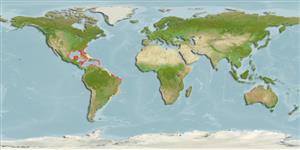Common names from other countries
Environment: milieu / climate zone / depth range / distribution range
বাস্তুসংস্থান
রীফ সংশ্লিষ্ট; ঈষৎ লোনা ; গভীরতার পরিসীমা 2 - 76 m (Ref. 108813). Tropical
Western Atlantic: Caribbean and Gulf of Mexico.
Length at first maturity / আকৃতি / ওজন / Age
Maturity: Lm ? range ? - ? cm Max length : 5.0 cm OT পুরুষ/ লিঙ্গ অনিধর্ারিত ; (Ref. 415)
Thick encrusting; 1 - 5 cm to massive amorphous. Black to dark brown or tan externally on parts unexposed to light, tan internally. Tough, firm, and cartilaginous (Ref. 415).
Maximum thickness: 5 cm (Ref. 415). Occasionally found on mangrove roots and peat banks. Common on reefs and lagoons (Ref. 415). Found on rocky substrates (Ref. 83912). Inhabits seagrasses, mangroves, coralline algae reefs, algal nodules, lower mesophotic and heavily silted reefs (Ref. 128739).
Life cycle and mating behavior
পরিপক্কতা | প্রজনন | ডিম ছাড়া | ডিমসমূহ | ডিম্বধারন ক্ষমতা | শুককীট
Members of the class Demospongiae are hermaphroditic. Life cycle: The zygote develops into parenchymella larva (free-swimming) before settling down on a substrate where it grows into a young sponge.
Collin, R., M.C. Díaz, J. Norenburg, R.M. Rocha, J.A. Sánchez, M. Schulze, A. Schwartz and A. Valdés. 2005. (Ref. 415)
IUCN Red List Status (Ref. 130435)
CITES status (Ref. 108899)
Not Evaluated
Not Evaluated
Human uses
| FishSource |
হাতিয়ার
ইন্টারনেট সুত্র
Estimates based on models
Preferred temperature
(Ref.
115969): 23 - 28, mean 26.1 (based on 296 cells).
Vulnerability
Low vulnerability (10 of 100).
Price category
Unknown.
